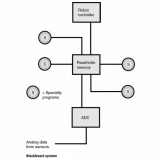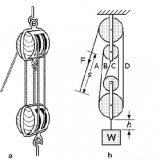RHex Rough-Terrain Robot (Boston Dynamics) – 11019
RHex is a six-legged robot with inherently high mobility. Powerful, independently controlled legs produce specialized gaits that devour rough terrain with minimal operator input. RHex climbs in rock fields, mud, sand, vegetation, railroad tracks, telephone poles and up slopes and stairways.
RHex has a sealed body, making it fully operational in wet weather, muddy and swampy conditions. RHex’s remarkable terrain capabilities have been validated in government-run independent testing. RHex is controlled remotely from an operator control unit at distances up to 700 meters. Visible/IR cameras and illuminators provide front and rear views from the robot.
Terrain Specifications
Traverses rock fields, mud, sand, snow, gravel, 60% inclines and other rough terrain
• Crosses railroad tracks, curbs, logs and pipes
• Culvert inspection
• Climbs stairs
• Rugged modular design for maximum reliability in harsh conditions
• Operator control unit (OCU) with live video feed for remote operation
• IP Radio with 400-700m range
• Modular payload bay for mission specific packages
Specifications
RHex is a power – and computation – autonomous hexapod robot with compliant legs and only one actuator per leg. It is the first documented autonomous legged machine to have exhibited general mobility (speeds at bodylengths per second) over general terrain (variations in level at bodyheight scale). RHex is presently capable of speeds exceeding five body lengths per second (2.7 m/s), negotiates a wide variety of rugged terrains over thousands of bodylengths (3700 m distance on one set of batteries), manages slopes exceeding 45 degrees, swims, and climbs stairs.
Size:
Weight: 27.5lbs without batteries
Dimensions: 22”L x 16”W x 5.2”H (legs not extended)
Power:
Battery: Two BB2590 Batteries
Endurance: 6 hours
Mobility:
Entrapment Risk: Extremely low
Speed: over 2mph on natural terrain
Slopes: Up to 60% slope walk, up to 84% climb mode
Vertical Step: 8.5”
Water Ford Depth: 6”+
Environmental:
Temperature: -15C to 45C ambient continuous operation
Water: IP67 sealed, water submersible
Exposure: Tolerant of humidity, salt, oil, sand extremes
Cameras:
Fore and aft cameras and illuminators
Driving Resolution: 320×240 pixels
Still Image Resolution: 1280×960 pixels
Illuminators: Adjustable 6W Visible, 6W Infrared
Capabilities of RHex
Throughout its development, RHex acquired a large number of capabilities in its behavioral repertoire. In fact, it is the only robot that is capable of performing such a wide variety of behaviors as a single, autonomous robot. This performance is due to the significant amount of inspiration from the study of biological systems, leading to a number of principles underlying RHex’s design.
- The use of legs instead of wheels or tracks opens the way for a large number of behaviors
- Passive compliance in the legs overcomes limitations of underactuation and helps simplify mechanical design, yielding robustness
- Sprawled posture, inspired from insects, results in passive stabilization of lateral motion
- Control is open-loop at the gait level, but closed loop at the task level. Stability comes as a result of passive mechanics, not high-bandwidth active control
At the end of the project’s five years, RHex was capable of performing the following, mostly open-loop behaviors
–Running on reasonably flat, natural terrain at speeds up to 6 body lengths per second (just over 2.7 m/s)
–Climbing a wide range of stairs
–Climbing slopes up to 45 degrees
–Traverse obstacles as high as 20 cm (about twice RHex’s leg clearance)
–Continuously run for 45 minutes, covering up to 3 miles with an efficient gait
–Successfully traverse badly broken terrain with large rocks and obstacles
–Walk and run upside down
–Flip itself over to recover nominal body orientation
–Leaping across ditches up to 30 cm wide
–Support remote control from up to 150m distance
in addition to a number of behaviors that increasingly relied on feedback from sensors such as the onboard gyro, camera and strain gauges on the legs.
–Perform autonomous stabilization of yaw heading while running using feedback from the gyro
–Autonomously follow a line on the ground without any operator control
–Perform simultaneous localization and mapping by using artificial landmarks scattered over natural terrain
–Locomote on only two legs using active pendulum stabilization
–Autonomously change the rest lengths of its leg springs
–Autonomously run systematic experiments to tune its running gaits
–Use inertial sensors in combination with leg strain gauges to accurately estimate its body pose
JUMPING RHEX Light Robot
Move aside, Sand Flea, you’re not the only jumping robot in town. The researchers over at the University of Pennsylvania have taught their little six-legged X-RHex Light to make leaps and bounds as well, making it one of a few bots to both run and jump effectively.

While it can’t spring as high as the Boston Dynamics critter, the X-RHex can cross gaps with not just a bound but a running gait, given enough room. It can also flip itself over, climb onto a ledge with a double hop and perform a leaping grab to something as high as 73 centimeters (28.74 inches).
The X-RHex itself isn’t new; the curved-legged contraption has been around for at least a couple years, and even sported a cat-like tail for balance at one point. Still, the fact that the hefty 6.7 kilogram (14.8 pound) machine can now somersault through the air is a quite a victory, and one that reminds us of the impending robocalypse.
Video Links
Youtube- http://youtu.be/ISznqY3kESI
Youtube- http://youtu.be/kV9J-oayCBU
Resource Links
http://www.bostondynamics.com
http://www.engadget.com/2013/05/10/x-rhex-light-jumping-robot/






